Chile adopted a new pension system featuring privately managed individual accounts in 1981. The system gives us an opportunity, based on more than 20 years of experience, to examine how pensioners and pension providers react when individual accounts replace government-run, defined benefit pension systems, and how various regulations shape these reactions. This paper focuses on the payout stage.
Retirees in Chile have a choice between early and normal retirement. They also can choose between annuities and programmed withdrawals. In general:
- Workers who choose annuities turn their retirement accounts over to an insurance company, and receive a guaranteed income for life, indexed for inflation; but they forgo the right to leave a bequest to heirs.
- Workers who choose programmed withdrawals leave the account with a pension fund administrator and withdraw annually an amount determined by a formula set by law; retirees can leave a bequest to their heirs, but they run the risk of exhausting the account before they die.
- Regardless of the option chosen, the government provides a safety net in the form of a minimum pension guarantee to all workers who have contributed to the system for at least 20 years.
Almost two-thirds of all retirees have chosen annuities – a very high proportion compared with annuities markets in other countries. However, early retirees and normal age retirees tend to make different choices. The normal retirement age is 65 for men and 60 for women, but many workers have met the preconditions to retire at an earlier age. (Early retirement means that they start withdrawing and may stop contributing; it does not necessarily mean that they stop working.)
- Currently 60 percent of all retirees have chosen to retire early, many before age 55, and 85 percent of them have annuitized.
- By contrast, 66 percent of normal age retirees have taken programmed withdrawals.
- Moreover, the average pension for early retirees is almost twice the average pension for normal age retirees, and among normal age retirees the average annuity is almost twice the size of the average programmed withdrawal.
These annuitization patterns are explained by regulations and guarantees that constrain payout choices, permit early retirement and give a competitive advantage to insurance companies selling annuities. Insurance companies market annuities aggressively and competition forces them to offer a high rate of return on price-indexed annuities. The minimum pension guarantee leads workers with small accumulations to take programmed withdrawals at the normal retirement age, while those with large accumulations acquire insurance against outliving their retirement savings (or a fall in the value of their savings) through annuitization at an earlier age.
Adverse selection occurs when people in poor health choose programmed withdrawals, while people with longer life expectancies choose annuities. Such behavior may have had a small impact on the system, but it does not seem to be a big problem, as indicated by the high rate of annuitization. As a result, the Chilean life insurance industry has grown from infancy in 1980 to an industry with annuity premiums that currently exceed $1 billion annually and reserves that exceed $10 billion.
The evidence suggests that, with appropriate incentives, a high proportion of pensioners in countries with individual account systems will purchase annuities. The Chilean experience also shows that in designing the payout stage, countries need to coordinate early withdrawal conditions with minimum pensions and other safety nets in order to avoid moral hazard problems and unexpected public liabilities.
[page]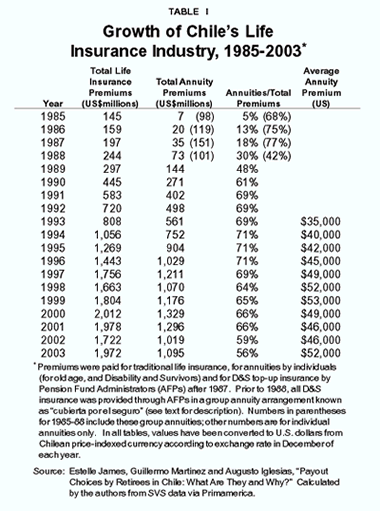
“Workers in Chile contribute to privately managed individual retirement accounts.”
1In 1981 Chile adopted a pension system featuring privately managed individual accounts. Traditional government-provided defined benefits for old age were eliminated in the new system. Starting in 1983, payouts from the accounts were permitted and detailed rules governing payouts were put in place. Now with more than 20 years’ experience, the Chilean scheme gives us an opportunity to examine how pensioners and pension providers react when individual accounts replace defined benefit systems, and how detailed regulations shape these reactions.
“Workers can purchase annuities with their account balances.”
What policies should regulators adopt toward annuities and other forms of payouts, and how will their regulations affect worker and insurance company behavior? The issues policymakers must consider include:
- Will retirees choose annuities over some other form of withdrawal, if given a choice?
- Will adverse selection pose a problem?
- Will the insurance industry grow rapidly enough to accommodate the potential new demand for annuities?
- Will attractive terms be offered to annuitants, or will much of the premium be siphoned off into administrative and marketing costs?
“Retirees receive monthly annuity payments.”
This paper focuses on the development of the annuities industry in Chile over the past two decades — its successes, failures and remaining problems. 2
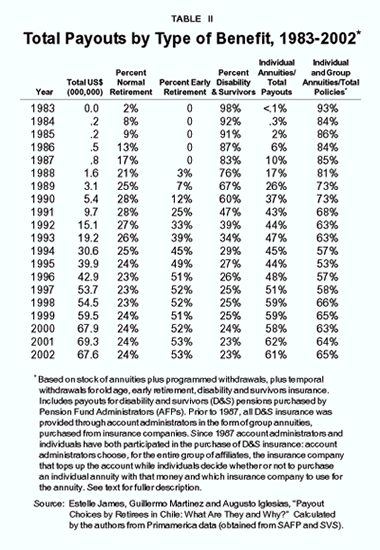
“Annuities are the chief life insurance product in Chile.”
Chile offers practically the only example of a large life insurance industry with annuities as its major product. In 1980 the Chilean life insurance industry was in its infancy, and the annuity portion was virtually nonexistent. However, the new social security system, which forced people to save for their retirement and greatly constrained their choices during the payout stage, changed this situation dramatically. The industry grew rapidly, and the annuity part grew fastest of all — measured by premiums, reserves and payouts:
- In 1985 life insurance premiums in Chile totaled only $145 million, but by 2000 they reached $2 billion.
- Two-thirds of premium income in Chile is for immediate payout life annuities, in contrast to the United States, where less than 2 percent of total life insurance premiums are for individual payout annuities and most of these are for fixed payout periods, not for life. [See Table I.]
- Payouts from annuities were less than $200,000 in 1985, but by 2002 they exceeded $40 million. [See Table II.]
- Life insurance reserves were less than half a billion dollars in 1985, but by 2003 they totaled over $14 billion, or 20 percent of GDP, mostly backing retirement. [See Table III.]
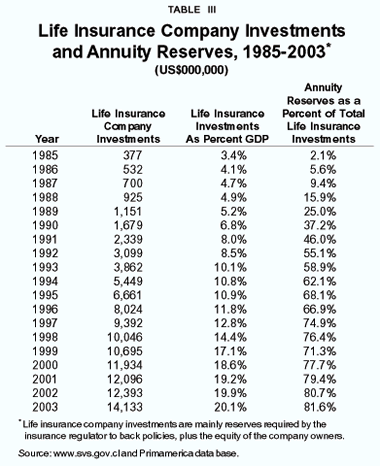
“Regulations limit workers choice of pension funds, retirement age and retirement income options.”
Chilean workers are required to contribute 10 percent of their wages (plus another 2.5 to 3 percent for administrative expenses and survivors and disability insurance) to personal pension accounts. The following text sums up the system. The accounts are managed by pension funds, known by their Spanish-language initials, AFPs. These funds must invest according to very strict guidelines. Payouts are also tightly circumscribed. Workers cannot access their funds for the purchase of a house, education or medical expenses, as they can in some other countries. For retirement, workers basically must choose between annuitization and programmed withdrawals.3 While the terms of an annuity are set on the date it is purchased, programmed withdrawal terms vary every year and retirees who start with them can switch to annuities later on. Additionally, workers must choose their age of retirement, subject to eligibility conditions described below. These are likely to be the key choices that are offered in many reforming countries. The only account-holders allowed to cash out some of their funds are those with accumulations large enough to produce a pension that is at least 120 percent of the minimum pension guarantee described below and at least 70 percent of the worker’s average wage over the past 10 years; the surplus over the amount necessary to fund this pension can be taken as a lump sum upon retirement. Few workers have met this requirement.4
“Workers are guaranteed an inflation-adjusted minimum pension that closely tracks the growth of real wages.”
The Minimum Pension Guarantee. Regardless of the option chosen, the government promises to keep the pension at or above the level of a minimum pension guarantee. This guarantee is available to all workers who have contributed to an individual account for at least 20 years. If the worker’s own accumulation is not enough to cover a minimum lifetime pension, the government provides a subsidy out of general revenues to bring it up to that level.5 An average wage worker should be able to reach the minimum level with 20 years of full time work. Therefore, those whose own pension is less than the minimum on their date of retirement have either earned less than the average wage or worked and contributed only part-time. After retirement, the minimum pension guarantee reduces the risk that workers will outlive their savings (longevity risk) or face a decline in the value of their stocks and bonds (investment risk), but it increases the risk to the public treasury, which is left with a contingent liability.6
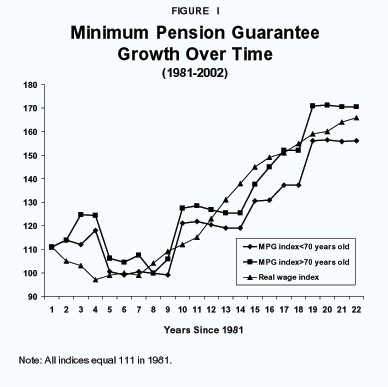
By law, the minimum pension is indexed to prices, but in reality it has kept pace with wages as a result of political decisions. During the 1980s, real wages fell in Chile and then recovered. The guaranteed benefit also fell and recovered, both with a lag. During the 1990s real wages rose steadily; the guaranteed benefit again rose more slowly, but caught up by the end of the decade. As Figure I shows, over the entire 21-year period, 1981-2002, real wages rose 50 percent while the guaranteed benefit rose 41 percent for retirees under age 70 and 54 percent for those over age 70.7 At the beginning of the period the guaranteed benefit was about 25 percent of the average wage, and by the end about 24 percent.8
When the guaranteed benefit rises, it rises for all retirees. Thus it may ultimately apply to annuitants as well as to low income pensioners taking programmed withdrawals. In effect, the minimum pension guarantee protects workers from the risk that the socially acceptable pension floor will rise during the period of their retirement. It jumps by about 9 percent for pensioners once they reach age 70, possibly because it is thought that they will run out of their voluntary savings by that time. It is reduced for early retirees by a formula that is based on the age of retirement from the pension system. This means that the minimum pension guarantee is specific to each individual — which in the long run may make it difficult to track and enforce. It also applies to survivors and disability benefits — widows supposedly receive 60 percent of the minimum pension guarantee based on their husbands’ savings, but because of special adjustments, they actually receive 100 percent of the guarantee.
How Annuities and Programmed WithdrawalsWork. Under annuitization, workers turn their entire accumulation over to an insurance company that provides the annuity, subject to detailed rules set by the insurance regulator. The retiree forgoes future control over investments and gives up the right to leave bequests (except for that embodied in a joint annuity or a guaranteed period annuity). In exchange, the retiree gets a stable income stream that is guaranteed for life. Regulations require annuities to be fixed rate rather than variable and price-indexed for inflation. For married men, the annuities must be joint with 60 percent of the husband’s annuity paid to a surviving spouse. (The Chilean government has just changed these rules to allow variable annuities and annuities issued in foreign currencies, but the new rules have not yet been implemented). If the amount of the guaranteed minimum benefit is larger than the annuity, the government tops up the payout. Above the minimum, the government insures 75 percent of the worker’s annuity up to about US$1,000 monthly, in case the insurance company becomes insolvent.
To prevent insolvencies, the government sets stringent reserve, equity and asset-liability matching requirements. So far it has never had to pay this insurance. Subject to meeting regulatory requirements, insurance companies determine annuity payouts and bear the longevity and interest rate risk. They are not permitted to charge explicit fees or to require annuitants to cover sales commissions explicitly.
“Instead of annuities, retirees can opt to gradually withdraw their funds.”
Under programmed withdrawals workers keep their money in a managed account and the permissible withdrawal per year depends on a formula that is based on assumed mortality and interest rates that are set by law.9 Workers retain control and bequest rights over the remainder of their accumulation, subject to regulatory constraints. Their investments may lose money, and even if they don’t the pension is likely to decline dramatically through time, due to the way the formula works (discussed below). If the payout falls to the minimum pension guarantee level, payouts stay at that level until the account is used up, at which point the government pays the guaranteed amount. Like annuities, programmed withdrawals must be joint for married men (and for women with dependents). The same companies that manage investments during the accumulation stage manage them during the payout stage, subject to rules established by the regulator. Fund administrators have no control over the formula that determines payouts nor do they bear the mortality and interest rate risks. (These risks are borne by retirees and, ultimately, by the government as guarantor.) In contrast to insurance companies, fund administrators are required to make all fees explicit and all investment earnings must be passed on to pensioners.
One group of retirees does not have a choice between annuities and programmed withdrawals. Those whose accounts are not large enough to purchase an annuity at or above the minimum pension must take programmed withdrawals and spend down their savings, after which the government pays the full minimum pension each month. Pensioners can become subject to this restriction some years after retirement, hitting the floor as the programmed withdrawal payout goes down while the guaranteed minimum pension rises. As of 2003, 70 percent of all programmed withdrawal pensioners (or 24 percent of all retirees) were in this no-choice situation.
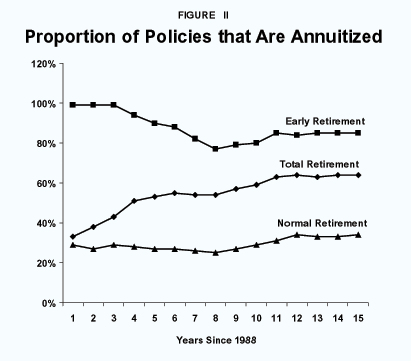
In sum, pensioners with annuities get a fixed payout, pay no fees except those implicitly embodied in this payout, and insurance companies get the varying residual; while under programmed withdrawals, account managers get a fixed explicit fee and pensioners get the varying residual. Both groups receive ultimate protection from the government safety net. Almost two-thirds of all retirees have annuitized and they constitute about three-quarters of those who had a choice at their date of retirement. [See Figure II.]10
“Most early retirees buy annuities, while later retirees make programmed withdrawals.”
Choice between Normal and Early Retirement Age. Workers must choose the age at which they will begin to withdraw their money from the system. Normal retirement age is 65 for men, 60 for women. After this age, any worker may begin withdrawing funds, regardless of how much he or she has accumulated. But starting in 1987, regulations began to facilitate earlier withdrawals by permitting early retirement once workers have an accumulation large enough to finance a pension that is 110 percent of the minimum pension guarantee and 50 percent of their own average wage. (The government has just decided to gradually change these requirements to 150 percent and 70 percent, respectively.)
“Early retirees usually do not stop working; but they do stop contributing to their accounts.”
For workers who meet these conditions, continued saving through the social security system becomes voluntary rather than mandatory. It is important to note that “early retirement from the system” does not mean “retirement from the labor force.” It only means that workers start withdrawing from, and may stop contributing to, their retirement accounts. In fact, the elimination of the required contribution of 13 percent of wages may have a positive impact on the labor supply of older workers.11 But the fact that workers can stop accumulating has a negative impact on their future pensions and the finances of the government. As Figure III shows, among current pensioners, 60 percent retired early, often before the age of 55.12
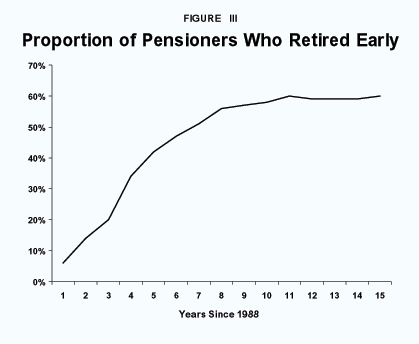
Indexing for Inflation. In Chile, both nominal (pesos) and price-indexed (UFs) currencies are in common use, and long-term financial transactions are usually quoted in the latter — a consequence of Chile’s long experience with inflation. Regulations require annuities to be issued in UFs. (In the future they may also be issued in select foreign currencies). Initial benefits are lower than they would be if they were peso-denominated, but the nominal value of UFs increases with inflation to maintain a constant purchasing power. For instance, an annuity issued in 1993 in Chilean pesos would have fallen to only 63 percent of its initial real value by 2002, and one issued in 1983 would have fallen to 5 percent of its initial real value by 2002. Price indexation avoids this problem of falling real values. It also saves the government considerable money, since annuities in nominal (current) pesos would be front-loaded — meaning they have a higher initial value, lower real value later on, and would quickly fall below a price- or wage-indexed minimum pension guarantee. Inflation-adjusted annuities, in contrast, maintain their value in real terms over time.
Monthly programmed withdrawals are also price-indexed and most of the investments backing them are price-indexed. However, programmed withdrawal payouts are recalculated every 12 months and, as discussed below, the formula yields a declining real value over the retiree’s lifetime. This increases the probability that the pension guarantee will eventually kick in.
“Joint annuities pay benefits to a worker's spouse, divorced spouses and dependent children.”
Joint Pension Requirement. As noted, married men who annuitize must use joint annuities, with the surviving widow receiving at least 60 percent of the husband’s annuity (if there are surviving dependent children, this becomes 50 percent to the widow plus 15 percent to each child). The formula for programmed withdrawal includes these same provisions for survivors, which diminish the amount that the husband can withdraw. This requirement provides insurance for widows financed by their husbands rather than by the public treasury. In effect, husbands must put aside some of their retirement savings to cover benefits to their wives, who are likely to be younger and outlive them. If the wife is five years younger than the husband and has a life expectancy that is three years greater than his — the typical case in Chile — this reduces his monthly payout by about 17 percent. [See Table V.]13 In contrast to males, females are not permitted to purchase joint pensions, unless they have disabled husbands or dependent children.
While many husbands would have chosen the joint annuity option voluntarily, some might have purchased an individual annuity in the absence of this requirement because they place a greater value on their own consumption. The wife is allowed to keep this joint pension in addition to her own pension, if she has worked. The mandatory joint annuity or joint programmed withdrawal saves the government money since, together with the surviving wife’s own pension, it often brings her income above the minimum pension guarantee point.14
Disability and Survivors Insurance. In the early years of the new system, few people retired with old age annuities since workers approaching retirement age were likely to remain in the old defined-benefit system15 and those who switched did not have many years in which to build their accounts. Initially most payouts were for disabled and survivors (D&S) beneficiaries, since demand for these occurred almost immediately as some workers died or became disabled. The new system specified a disability benefit equal to 70 percent of the worker’s average wage (50 percent for those with partial disability), and set up a complex schedule of survivors benefits. If an individual qualified for these benefits, the money in his account was topped up sufficiently to allow him to purchase the specified annuity or programmed withdrawal pension.16
“Accounts also fund disability and survivors benefits.”
Specifically, disability and survivors insurance takes place in two stages: In the first stage the pension fund administrator purchases a group contract with an insurer of its choice to put into the account of the disabled or surviving beneficiary an amount sufficient to purchase the required annuity. The insurance company is obligated to turn this into an annuity, if desired by the individual. The cost of this group insurance, less than 1 percent of wages, is passed on to workers. In the second stage the disabled worker decides whether the payout should take the form of programmed withdrawals or an annuity, and if the latter, from which insurance company to purchase the annuity. This procedure facilitated the early growth of a competitive annuity market, before the demand for old age annuities appeared. In 1983 disability and survivors benefits constituted 98 percent of all payouts and remained more than half of the total through the 1980s. However, old age pensions, particularly early retirement pensions, were growing in relative size as workers began to retire, and by the 1990s they dominated the industry. Currently, disability and survivors benefits comprise more than one-third of all policies but less than one-quarter of all payouts. As Table IV shows, about one-third of all outstanding disability and survivors policies are individual annuities.17
Disability and survivors annuities played an especially important role in getting the insurance industry off to a rapid start. A number of countries have moved from pay-as-you-go systems in which benefits for current retirees are funded by taxes on workers to multipillar systems, in which workers’ contributions to their own retirement accounts fund a large part of their benefits. These countries have varied rules regarding whether disability and survivors benefits are paid through the public or private sector or both. Allowing them to be paid through private insurance companies is an effective way to stimulate the growth of the industry in the early years of the new system, so when the much larger demand for old age annuities appears, the capacity already exists.
[page]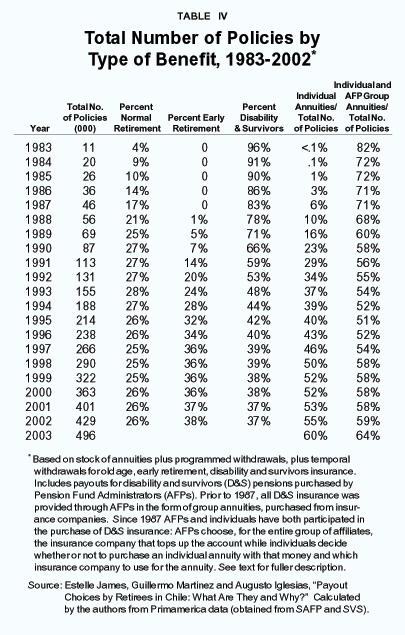
“Regulations encourage workers to purchase annuities.”
A key choice that retirees must make is whether to choose programmed withdrawals or annuities. Policymakers have an interest in this decision, since annuities are most likely to provide a steady stream of retirement income, which is a major aim of the social security system. Annuitization also reduces the liability that the government incurs through the minimum pension guarantee. Chile did not mandate annuitization, in part because of political opposition and in part to accommodate divergent interests among workers, some of whom may expect to die young. However, as mentioned earlier, two-thirds of all retirees do annuitize. Why this large percentage, which is far greater than in any other country? What lessons can other countries draw from this behavior? The high annuitization rate is likely due to six major factors:
- The demand for longevity and investment insurance and the absence of defined benefit plans or other institutions that provide such insurance;
- Regulations that constrain individual choice;
- Regulations that give insurance companies selling annuities a competitive advantage over pension fund administrators selling programmed withdrawals;
- The linkage between early retirement and annuitization;
- Marketing activities by insurance companies, exploiting that linkage; and Competition, which forces insurance companies to offer good terms — a high money’s worth ratio — to retiring workers.
We will discuss each of these factors in turn.
“The government guarantees poverty-level benefits.”
Longevity and Investment Insurance. When Chile’s new individual account system was adopted, it totally replaced a government-provided defined benefit plan that provided a lifetime pension. For workers who switched and for new entrants to the system, the public treasury no longer provided a benefit that insured against outliving their retirement savings or a fall in the value of their savings (that is, longevity and investment insurance). Very few employers in Chile provide such plans privately to their employees. Therefore, retirees who wish to ensure that they will not outlive their retirement savings must purchase an annuity. Adverse selection based on expected longevity, much discussed in the insurance literature, does not seem to dissuade them.
The one remaining type of defined benefit is the minimum pension guarantee, which provides longevity and investment insurance that is especially relevant to pensioners with small accumulations. Consider a worker whose initial programmed withdrawal pension is just slightly above the guaranteed level. The minimum pension guarantee sets a floor to the monthly income of this worker. Once his pension reaches that level, it cannot fall below. Instead, he must continue to withdraw his monthly pension at that level until his savings are used up, after which the government pays the pension for the rest of his life. Since the minimum pension guarantee provides longevity and investment insurance to such workers, they do not need to purchase annuities for this purpose. In contrast, workers with large accumulations must suffer a steep decline in their monthly pension before reaching the pension floor. If they don’t want to bear this risk, they must annuitize to get a stable lifetime income flow. We would therefore expect retirees with small accumulations to take programmed withdrawals while those with large accumulations would annuitize. But those with the largest accumulations might also choose programmed withdrawals, because they are willing and able to accept the longevity risk in order to get the higher expected return from programmed withdrawals and retain investment control plus bequest rights.
“Preretirement withdrawals are not allowed.”
In fact, this is exactly what has happened. Most workers who retire at the normal age have small accumulations that yield pensions in the neighborhood of the guaranteed amount, and two-thirds of these take programmed withdrawals. In contrast, the one-third who annuitize have an accumulation and average pension that is almost twice as large. Early retirees have much larger accumulations than normal age retirees, and 85 percent of them have purchased annuities. Retirees with large accumulations are much more likely to annuitize, because of their demand for insurance (against outliving their assets and the risk inherent in stock and bond investments) and the absence of other insurance alternatives. But the small group of early retirees with the largest accumulations choose programmed withdrawals. [See Appendix Tables II, III and IV.] This divergent behavior underscores the crowd-out effect on private annuity insurance that stems from publicly provided insurance. Without the minimum pension guarantee, it is likely that more workers with small accumulations would have annuitized, to acquire longevity and investment insurance.
Regulations that Constrain Individual Choice. As discussed above, Chile severely restricts the choice of payout. Lump-sum withdrawals are generally not permitted, nor are preretirement withdrawals allowed for housing, education or other purposes. This contrasts with other countries where lump-sum or fixed-period payouts are permitted (for example, Australia) or where funds can be withdrawn for housing (as in Singapore).18 In Chile, a person must meet the conditions for retiring and receive the money gradually, either through an annuity or programmed withdrawals.
Programmed withdrawals offer certain advantages to workers. They allow retirees to:
- Choose the investment strategy — choice of pension fund administrator and portfolio. Until 2003, each administrator could offer only one portfolio and all had similar investment strategies, but regulations now allow greater variety. This enables programmed withdrawal pensioners to invest in a riskier portfolio with a higher expected return than annuities.
- Get their money out of the system quickly. During the first few years of retirement, the programmed withdrawal formula produces payouts that exceed annuity payouts, and then vice versa, due to the required mortality and interest rate assumptions.
- Be sure that they and their heirs will receive back the full value of their accumulation, regardless of when they die (since they leave a bequest to their heirs if they die early).
- Switch to an annuity, if desired, later on, whereas the choice of an annuity is irreversible.
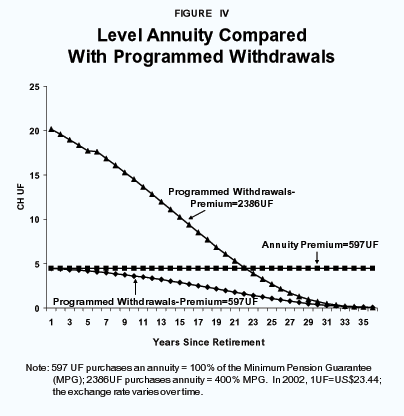
These advantages might make the programmed withdrawal option very attractive to retiring workers. But it has one big disadvantage: it does not provide investment and longevity insurance beyond the minimum pension guarantee.
“The income of retirees who withdraw funds declines over time.”
In the first year, the programmed withdrawal formula is exactly the same as the formula for an actuarially fair annuity; that is, if insurance companies and fund administrators assume the same future interest rates and mortality tables, annuities and programmed withdrawals will yield the same pension in the first year. However, a fixed-rate annuity payout remains constant, while the programmed withdrawal payout is recalculated every year. The programmed withdrawal will decline in the second year, because the expected life span increases for pensioners who have survived an additional year, and so on for successive years. [See Figure IV.] Additionally, regulations lead fund administrators selling programmed withdrawal pensions to assume higher mortality rates and higher rates of return than insurance companies selling annuities. This enables them to pay more in the first few years, but much less later on. Monthly payouts fall over time and will eventually become very small, in contrast to the level annuity. They fall even faster if investment earnings decline. This should deter risk-averse workers from choosing programmed withdrawals, except for those with small accumulations, who receive protection from a falling payout from the minimum pension guarantee. In any event, with the range of payout options so limited, and with gradual withdrawals required, annuitization becomes a more likely choice than it would be in a less constrained environment.
Regulatory Advantages to Insurance Companies. Insurance companies selling annuities have a competitive edge over fund administrators selling programmed withdrawal pensions. First of all, insurance companies are allowed to pay sales commissions to independent brokers, while account managers are not. Hence, workers who visit or are visited by a financial adviser to explore their options (as many do) are likely to be steered toward insurance companies and annuities. Since commissions are usually a function of premium size, brokers will be most interested in marketing to retirees with large accumulations.
Further, the differences in regulations governing fees are likely to lead pensioners to choose annuities sold by insurance companies rather than programmed withdrawal pensions sold by fund administrators, and to make the fund administrators prefer active workers over pensioners as clients. All fees charged by fund administrators must be explicit, and they are not permitted to sign long-term contracts binding these fees. The entire investment return must be passed on to the owner of the account. Although pensioners have large assets compared with workers, fund administrators cannot charge asset-based fees, and cannot charge any fee at all for pensioners receiving the minimum guarantee from the government, although this is the highest cost group to administer. The largest revenue source for pension fund administrators is fees based on contributions (which are made mainly by workers, not pensioners).
In contrast, insurance companies are not permitted to charge explicit fees for annuities. Instead, they can only quote a monthly payout and must cover their costs and profits from the “spread” — the difference between the present value of this payout and the premium that is paid. In effect, the “price” of the annuity is hidden, and the retiree may not even be aware that there is any fee. Annuity payouts are obliged to remain stable regardless of how insurance company costs and spread change, while pension fund administrators’ fees may change in the future in ways that diminish pensions.
“The early retirement option encourages workers to purchase annuities.”
Early Retirement and Its Link to Annuitization. Early retirement — before age 65 for men and age 60 for women — poses the danger that many early retirees will have low incomes in very old age, especially if they choose programmed withdrawals. If they become eligible for the minimum benefit, there is a potential cost to the treasury. However, in Chile early retirement has become the lure for workers to annuitize, greatly mitigating these dangers. The net result is that a majority (60 percent) of pensioners have retired early and an overwhelming proportion of early retirees (85 percent) have annuitized. [See Appendix Tables II, III and IV.] Among annuitants, early retirees outnumber normal age retirees by almost 4 to 1. Thus, early retirement and annuitization are inextricably linked.
The conditions for early retirement were stringent at the beginning of the new system, but were loosened during the 1980s. Initially early retirement was allowed only if the worker could acquire a pension that was 100 percent of the pension guarantee and 70 percent of his own average wage over the past 10 years — a condition that was difficult to meet. However, in 1987 the required replacement rate was reduced to 50 percent of a worker’s own wage but the pension guarantee requirement was increased to 110 percent. In making this calculation, nominal wages from the past are price indexed and months without wages are averaged in as 0s, so unemployment (whether voluntary or involuntary) helps a worker to qualify. Also, starting in 1987 employers who wished to facilitate a worker’s early retirement could put extra money into his retirement account. And workers were allowed to sell to insurance companies the recognition bonds (bonos de reconocimiento) that they had received in return for their contributions to Chile’s old system prior to 1981. These bonos became part of the premium for an early retirement annuity. In contrast, pension fund administrators could not buy bonos until 1990, which greatly hampered their ability to compete in the early retirement market.
“Insurance companies actively compete for business.”
How Workers Learn They’re Eligible: Marketing by Insurance Companies. Given this potential market and the competitive edge provided by regulations, insurance companies and brokers eagerly seized the opportunity to identify clients, lure them away from the funds where they were contributing workers, and sell them early retirement annuities. Eligibility was complicated to determine, but insurance salesmen figured this out and promptly informed qualifying workers. According to anecdotal evidence, some brokers made loans to workers to put into their personal accounts, thereby enabling them to meet the eligibility criteria faster. Insurance companies and brokers handled the paperwork, bought the bono early and calculated the maximum allowable lump sum withdrawal.19 It is widely believed that sales commissions were shared with new annuitants as unofficial rebates. Of course, when they sold early retirement, they also sold annuities. They focused their attention on workers with large accumulations, who were more likely to meet the eligibility conditions and would also yield a higher commission to brokers and larger profits to insurance companies. As a result, as noted above, early retirees have larger pensions than normal age retirees and are highly likely to annuitize.20
In contrast, fund administrators could not pay commissions to independent brokers and did not actively market programmed withdrawal pensions. They got higher fees if affiliated workers remained contributors rather than becoming retirees. Marketing costs are sometimes disparaged as a payoff to aggressive salespersons in a zero- or negative-sum game. However, in this case marketing by insurance companies provided useful information about the early retirement regulations set by government and pushed retirees in the direction of annuitization, which minimizes risk for government and pensioners.

“Annuities give workers a high return on their investment.”
The High Money’s Worth Ratio of Price-Indexed Annuities. A final reason for the high rate of annuitization in Chile is the high return on investment, or money’s worth ratio, that annuitants receive. When an annuity premium is paid in, it is gradually returned to the annuitant over his or her expected lifetime. The money’s worth ratio is the present value of the entire lifetime income stream that an annuitant expects to receive, divided by the initial premium.21 If the ratio is 100 percent, this means that consumers can expect to get back all the money they paid in, in addition to interest plus longevity and investment insurance. If it is considerably less than 100 percent, consumers are getting back a lot less than they put in and they may not purchase the annuity. If it is much greater than 100 percent, insurance companies may be offering too much in order to gain market share in the short run and may not be able to keep their promises in the long run. In Chile, the money’s worth ratio is close to 100 percent.
To make this computation, we surveyed several insurance companies in March 1999 and again in March 2003 and computed the average payout each year for several different annuity products. Since annuities involve payouts far into the future, it is necessary to discount the income stream, and the present value is very sensitive to the discount rate chosen. We therefore used two alternative discount rates: a low risk-free (government bond) discount rate and a higher-risk investment discount rate.22
“On the average, retirees get back all the money they put into the system.”
It is also necessary to take into account the expected lifetime of the annuitant, based on mortality tables. We used two different mortality tables in our analysis: a 1985 mortality table, which is used by regulators but probably understates longevity, and a 1998 table based on more recent data, with lower mortality, which is not yet used officially but is probably closer to the truth.
Using the 1998 mortality table and the risk-free discount rate, we found that the money’s worth ratio for a 65-year-old male is 98 percent. This means that the typical annuitant gets back almost the full premium over his lifetime, in addition to the risk-free interest rate and insurance. The ratio is 5 to 10 percent lower when the 1985 mortality table or the risky discount rate are used. People whose mortality is represented by this high mortality table (perhaps because they are poor or in ill health) are unlikely to recoup their full premium and may be better off choosing programmed withdrawal — which may be one reason why workers with small accumulations choose that option. Workers who prefer a riskier investment with higher expected returns may discount at the higher rate and decide they are better off choosing their own investment strategy under programmed withdrawal. But the average worker whose longevity is represented by the 1998 table and who wants a safe retirement income gets a very good deal in the Chilean annuity market. Annuity payouts declined 15 to 20 percent between 1999 and 2003 due to falling interest rates, but, as Table V shows, the money’s worth ratio did not fall.
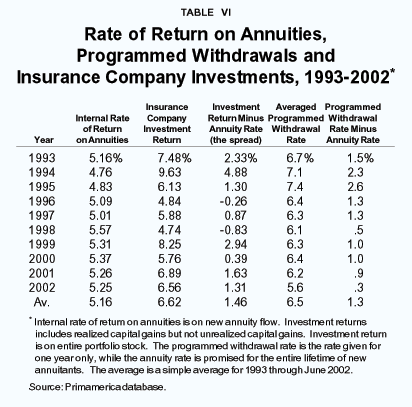
“Annuities are adjusted for inflation.”
Money’s worth ratios in the neighborhood of 100 percent have been found in many other countries, as well. However, annuities in other countries are usually not inflation-adjusted, and for price-indexed annuities the ratio is considerably less than 100 percent. Insurance companies are usually reluctant to offer price-indexed annuities because indexed investment instruments with which to hedge this risk are not available or pay a low rate of return. Also, if indexation is voluntary, it is more likely to be chosen by retirees with greater expected longevity — adding to their expected cost. For these reasons, if insurance companies do offer indexed annuities, they impose a high price in the form of a low money’s worth ratio. For example, the money’s worth ratio that annuitants receive for indexed annuities is 89 percent in the United Kingdom compared with 98 percent for nominal annuities.23 In Chile annuitants get a 98 percent return for indexed annuities. Indexed annuities provide a better return in Chile because insurance companies have a choice among many inflation-indexed investment instruments and because indexation is mandated, hence it does not cause adverse selection as it might in the voluntary market. The fact that annuities are inflation-proof in Chile makes the high money’s worth ratio especially impressive and makes annuities especially attractive to retirees.24
“Insurance companies operate on a small margin between earnings and payouts.”
Importance of the “Spread.” How do insurance companies manage to cover their costs and profits while repaying the full premium and providing longevity and investment insurance to annuitants? Their earnings come from the difference between the risk-free rate that they pay annuitants and the risky rate that they earn on the diversified portfolios in which they invest the premiums.25 These portfolios include long-term public and corporate bonds, mortgage-backed securities and some equities. The insurance companies reduce the risk inherent in these securities by a variety of techniques such as investment diversification, use of derivatives, reinsurance, negative correlations among product lines, keeping reserves that exceed liabilities, using shareholder net worth as buffers, and, ultimately, government guarantees. To a limited extent they also invest in long-term instruments whose rates have not fallen nearly as much as short-term rates, while covering short-term payouts out of cash inflows. In addition, insurance companies earn a premium owing to their capacity to invest in illiquid instruments. As a result of these measures, the spread between the rates paid and earned in Chile has historically exceeded 1.4 percent per year, which is enough to cover their costs. [See Table VI and Figure V.] It remains to be seen whether this spread and the high money’s worth ratio it supports can be maintained in the future, as interest rates fall.
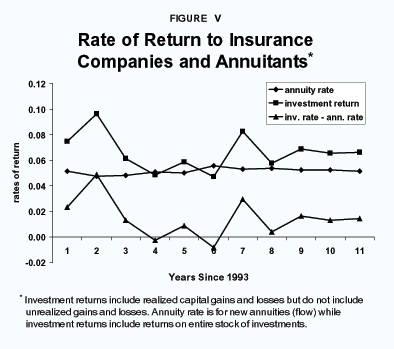
“Annuities do not appeal just to people who expect long lives.”
Do Workers with Poor Health Opt Out of the Annuity Market? If insurance companies expect annuities to be purchased predominantly by people with good health, they will set their payouts accordingly, which will lead to bad terms for people with poor health, who consequently will not purchase annuities. This could lead to a breakdown of the annuity market through the well-known process of adverse selection. This is sometimes used as a rationale for a public defined benefit plan or for compulsory annuitization under a private defined contribution plan. Data from Chile throw some light on this question.
First of all, with such a high rate of annuitization, it is clear that the market has not broken down, and that annuities do not appeal only to a small group of healthy people. This is due in large part to the regulations described above and to the marketing activities of insurance companies. The joint annuity requirement further reduces potential adverse selection because the expected lifetimes of both spouses, which are not perfectly correlated, will be taken into account. Insurance companies in other lines of business reduce adverse selection by putting customers into different risk categories and pricing differentially according to their expected risk. Family background, DNA and health examinations could be used for this purpose in the annuity market — but this does not seem to happen in Chile. However, gender-specific mortality tables are used in Chile, thereby avoiding adverse selection based on gender.
We could not compare the mortality rates of retirees who chose programmed withdrawals versus those who chose annuities, since we did not have mortality information on programmed withdrawal pensioners. However, we do have information about mortality rates of annuitants, which enabled us to compare the actual death rate with the expected death rate of various sub-groups based on population mortality tables. Our findings, as summarized in Table VII, show that:
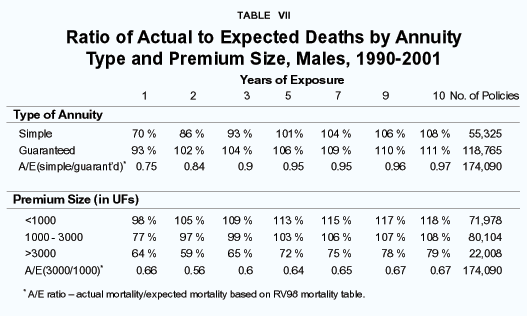
- The ratio between actual and expected mortality rates of annuitants was relatively low shortly after they retired, but grew sharply in the medium term. This suggests that retirees who know they are in bad health and likely to die soon are less likely to purchase annuities, but this effect of private information is concentrated in the first two to three years after retirement; after that mortality stabilizes near the expected level for the population.
- The ratio between actual and expected deaths was higher for retirees who purchased annuities with a guaranteed payout period (such as 10 or 15 years) rather than a simple annuity. This suggests that workers who suspect they are in ill health may still purchase annuities, but they choose an annuity product that continues the payment to their heirs.
- Annuitants with higher premiums have lower ratios of actual to expected deaths, which is consistent with the correlation between wealth and longevity that has been noted in other cases. However, insurance companies do not use this information to give them inferior terms — and in fact seem anxious to market to this group — perhaps because they get access to larger assets on which to earn the spread and because the lower administrative cost per dollar of premium offsets the greater longevity due to economies of scale.
“Most people cannot accurately predict when they will die.”
Thus, some selection according to private information seems to exist, but mainly about short-run mortality probabilities, and it does not lead to a breakdown of the annuities industry. Retirees who want the insurance that annuities provide but suspect they will die young can choose an annuity product (such as annuities with guaranteed payment periods) that does not penalize those with short lifetimes. It is important for regulators to allow product variety to keep these people in the market. Retirees with small accumulations are more likely to have shorter lifetimes and are less likely to annuitize — but the minimum pension guarantee is the most obvious explanation for this behavior. Overall, these facts suggest that asymmetric information is not a major source of adverse selection nor does it have a large impact on size of the annuities market in Chile.26
[page]“Assumptions about how long people will live are important.”
Despite the rapid growth of annuitization and the high money’s worth ratio available to annuitants, the pension industry in Chile faces some serious problems. These include:
- uncertainty about future interest and mortality rates,
- front-loading of the programmed withdrawals formula,
- overly easy preconditions for early retirement and
- a potentially large contingent liability for the government as a rising minimum pension guarantee conflicts with early retirement and front-loaded programmed withdrawals.
Uncertain Interest and Mortality Rates. When an insurance company issues an annuity, it is guaranteeing a lifetime investment return for the annuitant. If interest rates fall or longevity increases, the insurance company bears this risk and must cover the cost. Each insurance company makes its own assumptions and decides how much risk to bear. But competition may force it to make assumptions that are favorable to annuitants. For example, companies may assume that future investment returns will be higher so generous payouts can be promised. When interest rates were higher than they are today, annuities were sold under the assumption that these higher rates would be maintained. If interest rates stay low or fall further, insurance companies could find themselves in financial stress.
“Workers should not be allowed to withdraw their funds too quickly.”
Insurance companies also use an assumed set of mortality tables in their payout calculations. Our estimates of the money’s worth ratio were also based on an assumed mortality table — the 1998 table — which is roughly similar to that used by the industry. However, in reality no one knows for sure how long people will live in the future. A man who turns 65 in 2010 may live much longer than one who turned 65 in 1998 or 1985, due to improvements in medical technology and lifestyle in the interim. So far Chile has not built a “cohort mortality table,” such as American insurance companies have, that takes account of these projected mortality improvements (and, indeed, these projections themselves are uncertain). The insurance industry runs the danger of serious financial trouble if such tables are not built, and if annuitants outlive the expectations built into the annuity terms. In the extreme, if insurance companies cannot meet their obligations, this becomes a public liability, due to the government’s guarantee of the minimum benefit and 75 percent above that level.
Front-Loading of Programmed Withdrawals Due to Mortality and Interest Rate Assumptions. The allowable programmed withdrawals also depend heavily on the mortality table and interest rate structure used in the calculation, and these are specified by the pension fund regulator. When assumed mortality and interest rates are higher, the initial allowable programmed withdrawals payout is higher — it becomes more front-loaded. But if these are overstated, the retiree’s accumulation is used up faster than it would be otherwise. This risk of low pensions in the future due to exaggerated mortality and interest rates is passed on to workers and, eventually, to the public treasury, which must pay the minimum pension when the workers’ accounts are depleted. The pensioner gets more at first but the government pays more later on.
Currently the pension fund regulator requires use of the 1985 mortality table for programmed withdrawals. This overstates mortality rates for annuitants. The regulator argues that it may be more applicable to the programmed withdrawal population, which includes many low earners with low accumulations forced by regulations to take programmed withdrawal. However, mortality data are not available for these pensioners that would allow us (or the regulator) to test this hypothesis. If the pensioners live longer than expected, the government may be left with a large bill.
Interest rate assumptions are another key ingredient in the programmed withdrawal formula. Initially a 0 percent future return was built into the formula, but this was deemed implausible and it produced very low pension payouts. In 1987 the regulator changed this to a positive real interest rate to improve payouts — 80 percent based on the previous year’s internal rate of return on new annuities and 20 percent based on the fund administrator’s average real return over the last 10 years. Pension fund returns were extremely high during the 1980s and early 1990s, while interest rates on annuities (and other investments) have been falling recently. This produces an assumed interest rate for programmed withdrawals that is about 0.5 to 1.0 percentage points higher than the current annuity rate and even higher than the current long-term interest rate. [See Table VI.] This backward-looking method of imputing returns may overestimate expected future returns, when interest rates are falling. Such an overestimate would increase the programmed withdrawal pension in the early years, but the larger withdrawal as well as the smaller investment return that is actually earned would reduce the retiree’s pension and increase the government’s liability in later years.
These programmed withdrawal problems could be avoided by using more conservative assumptions in the formula and by requiring that pensioners also purchase a deferred annuity that begins much later, say at age 80, that would cover the minimum pension.
“Workers should not be allowed to retire too early.”
Early Retirement. Allowing workers to retire early also builds a contingent liability that could have been avoided if they had retired at the normal age. For example, if a worker who started withdrawing at age 60 instead kept his money in the account until age 65, the resulting larger accumulation and shorter future life span would finance a pension that was 50 percent greater. His income in old age would then be greater and the probability that he would some day require a government subsidy would be commensurably smaller. Viewed from this perspective, the government has recently taken steps to tighten access to retirement savings through early retirement — requiring 150 percent of the guaranteed pension and 70 percent of own wage before a worker gets this privilege. However, these conditions may not be sufficient. Possibly 200 percent of the minimum pension guarantee should be required, as the guarantee could easily double over the remaining lifetime of an early retiree, if it continues to be linked to wage growth.
Wage-Linked MPG. In Chile the minimum pension guarantee has been rising on par with wages and faster than prices, while annuities are price-indexed and programmed withdrawal pensions fall in real value as the pensioner ages. Eventually, the rising real pension floor is bound to collide with a constant or falling private pension, which means that the government will then be responsible for paying the difference. The challenge is to make policy regarding the safety net consistent with policies regarding pension payouts. This could be accomplished by partially price-indexing the guaranteed pension amount (rather than linking it to wages) to slow down its growth or by requiring that annuities and programmed withdrawals use an escalating formula (start lower and rise through time) so they are less likely to conflict with a rising pension guarantee.
“The design of an individual account system is crucial to its success.”
The costs of the minimum pension guarantee do not appear when a retiree is “young” since initially his pension exceeds it. I have projected that many pensioners will begin to reach the pension floor in their late 70s or early 80s, as the guaranteed amount rises and programmed withdrawal pensions fall.27 Similarly, in a new system, aggregate costs of the pension guarantee will appear negligible, because retiring cohorts are “young” and don’t yet qualify to receive the public benefit. But as the system matures and some retired cohorts become “very old,” total costs will escalate. This is about to happen in Chile. The rapid increase in number of very old cohorts that will take place over the next decade will bring about a sharp and possibly unexpected acceleration in the proportion receiving the public benefit. This underscores the importance of simulating the long-term flows from private pensions and the public safety net under different scenarios and designs to enable informed choices about payout policies and trade-offs. Such simulations have not been done in the past in Chile, but they are likely to become increasingly important in the future.
[page]Our evidence suggests that the major reasons for the high rate of annuitization are the regulations, guarantees and incentives built into the Chilean pension system. This structure has also stimulated the development of a new multi-billion dollar industry — the life insurance industry, specializing in annuities — practically from scratch. It is ironic that marketing, which has been the subject of much criticism during the accumulation stage, seems to play a socially useful role — encouraging annuitization — during the payout stage. Two-thirds of all retirees have annuitized and annuitization mitigates some of the risks of early retirement faced by pensioners and the public treasury.
The good news for other countries is that:
- Detailed regulatory policies can strongly influence worker and pensioner behavior, and in Chile have gone far toward ensuring lifelong security for workers and their spouses.
- In Chile these regulatory policies include ruling out almost all lump sum distributions at retirement and any distributions prior to retirement, requiring price-indexed and joint pensions, and permitting work without contributions after a specified accumulation level has been reached.
- Life insurance companies quickly developed in response to the demand for annuities, further stimulated this demand by aggressive marketing and provide a high money’s worth ratio for price-indexed annuities (enabled by the availability of many indexed financial instruments in Chile).
- Under these conditions, adverse selection due to asymmetric information does not seem to pose a major problem. l It appears that with appropriate incentives a high proportion of pensioners will purchase annuities that provide longevity insurance and reduce the government’s fiscal liabilities.
But important caveats also emerge:
- In Chile regulations give insurance companies selling annuities a competitive edge over fund administrators selling programmed withdrawal pensions.
- Programmed withdrawals may lead to low retirement incomes or high public subsidies for the very old, unless they are buttressed by deferred annuity requirements.
- If early withdrawal is permitted, many workers seem to choose that option, so early withdrawal conditions must be chosen with great care.
- If these payout rules are not well coordinated with minimum pension guarantees and other safety net provisions, this may lead to moral hazard problems and unexpected public liabilities in the future.
NOTE: Nothing written here should be construed as necessarily reflecting the views of the National Center for Policy Analysis or as an attempt to aid or hinder the passage of any bill before Congress.
[page]- This paper is based on data and analysis provided in Estelle James, Guillermo Martinez and Augusto Iglesias, "Payout Choices by Retirees in Chile: What Are They and Why?" paper presented at the annual meeting of the American Economic Association, January 2004. The author wishes to thank the Michigan Retirement Research Consortium and the Social Security Administration for their support on this project, and the many representatives from insurance companies, the pension fund administrators (AFPs) and their regulators (SVS and SAFP) in Chile who shared their information and insights. Jorge Lillo performed the analyses of mortality rates among annuitants, Xue Song performed the money's worth calculations, and Juan Pablo Contreras assembled much of the aggregate data.
- We use three types of data sources in this analysis: First, aggregate time series data on annuities and programmed withdrawals, 1983-2002, were obtained from the insurance regulator (the Superintendencia de Valores y Seguros or SVS) and the regulator (the Superintendencia de AFP or "SAFP") of pension fund administrators (the Administradoras de Fondos de Pensiones or "AFPs"). Second, SVS provided individual-level data on all annuitants giving gender, size of accumulations and pensions and dates of birth, retirement and death. In this paper, these data are used to report descriptive statistics on annuitants and to compare expected versus actual mortality rates across groups. Unfortunately, reliable individual-level data on pensioners who chose programmed withdrawal (PW) pensions were not available. Third, the author held extensive discussions with insurance companies, AFPs and regulators in Santiago, and obtained annuity quotes from several companies for 1999 and 2003, from which money's worth ratios were calculated. For more details on data, see James, Martinez and Iglesias, "Payout Choices by Retirees in Chile: What Are They and Why?" and James, Martinez and Iglesias, "The Payout Stage in Chile: Who Annuitizes and Why?" working paper, 2004.
- The start of the annuity payout can be postponed two to three years through a program called "temporal withdrawals," in which workers purchase a deferred annuity upon retirement, but initially take programmed withdrawals; however, few retirees have taken this option.
- In August 2004 the Chilean government adopted some changes in its payout scheme that will be gradually phased in by 2010. Forms of payout have become more flexible. For example, variable annuities and annuities denominated in foreign currencies will be permitted as soon as implementing regulations are developed, a pension that combines an annuity plus programmed withdrawal will be allowed in the future, and banks will be authorized to sell annuities. At the same time, the requirement for early retirement is gradually being raised (to 70 percent of one's own wage and 150 percent of the minimum pension guarantee), the definition of average wage used in this requirement has been tightened, a limit has been set on sales commissions to brokers selling annuities and an electronic quotation system is now required for annuity sales. The greater flexibility and increased information should make annuities more attractive but the tightening of early retirement preconditions might reduce demand and restrictions on commissions might reduce marketing costs and impact. This paper analyzes the system that has been in effect for the past 22 years.
- To receive government funds to bring their pension up to the minimum level, workers must attest that they have no other income sources that bring them above that level. This means test is enforced by the fund administrators or insurance companies paying the pension, which are required to secure documents from the tax authority and the old pension authority confirming the absence of other income.
- One advantage of a minimum pension guarantee is that it is relatively easy to implement administratively – simply by checking the individual's own annuity or programmed withdrawal pension. The transaction costs are much lower than for means-testing based on more general income and assets. However, this also means that some individuals with small pensions but large nonpension wealth or income get a public subsidy – which many would regard as a poor use of public funds. Chile attempts to avoid this possibility by making eligibility for the top-up contingent on the absence of other sources of income. But this reintroduces a means test and the transaction costs it implies. Chile passes these enforcement costs on to the fund administrators and insurance companies. This makes retirees with low pensions expensive to such companies, and undesirable if these costs can't be recouped. While required to enforce means-testing, these companies have little incentive to do so carefully. We are unable to assess how effectively the broader income test is implemented.
- For details, see Appendix Table I.
- If it had been indexed only for price inflation, the minimum pension would have fallen to 17 percent of the average wage and if not indexed at all, to barely 1 percent.
- The programmed withdrawal (PW) formula for an individual pension is
Premium = 12*p*prem + EPV(UF15), where:
Premium = retiree's total accumulation
p = monthly pension, whose value is being ascertained by this formula
prem = EPV of pension that equals 1 UF monthly = (Nx/Dx- 11/24)
Nx and Dx are standard actuarial factors that depend on mortality and interest rates
EPV(UF15) = expected present value of UF15, which is the necessary capital for the funeral benefit of Chilean UF15 that must be included in all policies
In the common case of a joint withdrawal, in determining p and prem enough capital must be set aside to cover 60 percent of p for the surviving spouse, as well as p for the pensioner, so prem = (Nx/Dx- 11/24) + .6(Ny/Dy- Nxy/Dxy).
This is exactly the same as the formula for an annuity and will produce the same payout for a given premium if the same mortality and interest rates are used. - For full details, see Appendix Tables II and III.
- The 13 percent figure is based on a 10 percent net contribution plus 3 percent for administrative expenses and disability and survivors insurance. The increase in liquidity of retirement savings and in monthly income flows may lead some workers to withdraw from the labor market. This would hold for workers who have been forced to save more than they would have chosen for their retirement, and who prefer to spend some of that saving on leisure instead of material consumption. But the elimination of the 13 percent payroll tax may have a positive effect on continued labor supply. The liquid wealth and the substitution effects therefore work in opposite directions in influencing the labor supply of older workers. In either case, workers can no longer increase the present value of their pension by withdrawing from the labor force, as they could in the old defined benefit system. This reduces the incentive that existed in the old system to stop working early. Preliminary evidence indicates that the labor force participation rate of older workers has been rising since the mid-1980s, very likely as a result of the pension reform.
- Appendix Table IV shows details.
- Also see Estelle James, Alejandra Cox Edwards and Rebeca Wong, "The Gender Impact of Pension Reform: A Cross-Country Analysis," World Bank, Research Working Paper No. 3074, 2003.
- Simulations show that the expected widow's benefit exceeds both the own pension of the average working woman and the minimum pension guarantee; see Estelle James, Alejandra Cox Edwards and Rebecca Wong, "The Gender Impact of Pension Reform," Journal of Pension Economics and Finance, 2003. Chile also has a means-tested social assistance program for the destitute elderly. Widows who receive the joint annuity are less likely to qualify for social assistance. The requirement that most wives purchase individual pensions also saves money for the government, since it yields a higher monthly payout for a group that tends to contain many low earners and greater life expectancy. This means that fewer women annuitants will qualify for the MPG than would be the case if they purchased joint annuities.
- Under the old system, workers received a defined benefit, which is like an annuity. Most workers over the age of 55 remained in the old system. Therefore, the new system did not have many old age retirees during the 1980s.
- Prior to 1987 D&S benefits were provided directly by the pension fund administrators (AFPs). The AFP typically insured these benefits through an affiliated insurance company, an arrangement known as "cubierta por el seguro." Often these companies were in the same financial conglomerate as the AFP, so the purchase was not made at arm's length in a competitive market. These benefits were like forced group annuities, in the sense that they provided longevity and investment insurance to beneficiaries, but the terms and vendor were chosen by the AFP rather than by the individuals who ultimately paid the insurance premiums. In 1987 this system was changed to the system described in the text.
- Also see Appendix Tables II and III.
- In Singapore these withdrawals have led to a heavy investment in housing by workers and to very low cash balances upon retirement. It remains to be seen which choices will be made in Australia, where the system is relatively new, so few workers have retired under it. The combination of unconstrained choice and insurance provided by the means- and asset-tested old age pension on relatively generous terms makes it unlikely that most people will annuitize.
- If the worker has enough money in his account to purchase a pension that is at least 70 percent of his average wage, he is allowed to draw the rest in a lump sum. Few workers achieve this size accumulation. However, insurance companies can help them do so – for example, by lending them money to put into the account to achieve the 70 percent replacement rate.
- Also as expected, early retirees who do not annuitize have much larger accumulations and pensions than those who do annuitize. This may occur because wealthier individuals are better able to acquire their own information about early retirement and to self-insure against longevity and investment risk. They may also be more anxious to manage their own investment strategy, to take greater risks in order to get a greater return, and to leave a bequest to their heirs – all of which are possible with programmed withdrawals but not with annuities.
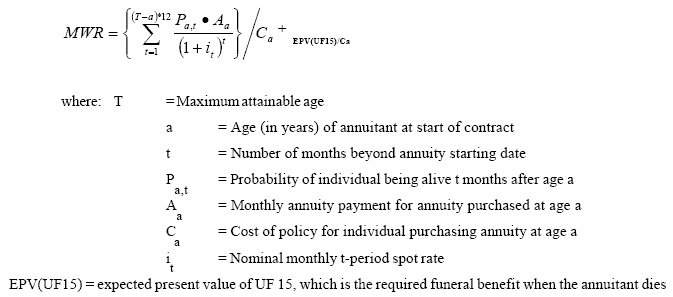
Concretely, the money's worth ratio for a single life annuity is:- Actually, we used the term structure of interest rates, which gives a different rate for income flows in different periods. For 2003 the risk-free term structure was based on 0 coupon bonds while for 1999 it is based on central bank bonds of differing maturities, since 0 coupon bonds did not exist at that time. The risky rate was defined as risk-free +1.4 percent, which is approximately what insurance companies in other countries, as well as Chile, have earned, on average per year, over the past decade. See Estelle James and Xue Song, "Annuity Markets Around the World: Money's Worth and Risk Intermediation," CeRP Working Paper 160/0, 2001.
- In the mandatory part of the U.K. system annuities must be indexed up to a ceiling of 5 percent inflation. Other countries with new multipillar systems are considering requiring indexed annuities, but this may be difficult to implement given the absence of indexed financial instruments. See Mamta Murthi, J. Michael Orszag and Peter Orszag, "The Value for Money of Annuities in the U.K.: Theory, Experience and Policy," Birkbeck Working Paper, 1999; also see Amy Finkelstein and James Poterba, "The Market for Individual Annuity Products in the United Kingdom," National Bureau of Economic Research, NBER Working Paper No. 7168, 1999, and Finkelstein and Poterba, "Adverse Selection in Insurance Markets: Policyholder Evidence from the U.K. Annuity Market," National Bureau of Economic Research, NBER Working Paper No. 8045, 2000.
- For further discussion of the MWR in other countries, see Estelle James and Xue Song, "Annuities Markets Around the World: Money's Worth and Risk Intermediation," and Estelle James, Xue Song and Dimitri Vittas, "Annuities Markets in Comparative Perspective: Do Consumers Get Their Money's Worth?" World Bank, Conference on New Ideas for Old Age Security, 1999.
- For a detailed discussion of the spread, see Estelle James, Xue Song and Dimitri Vittas, "Annuity Markets Around the World: Money's Worth to Annuitants and How Do Insurance Companies Cover It?" Working Paper, 2003.
- See Estelle James, Guillermo Martinez and Augusto Iglesias, "The Payout Stage in Chile: Who Annuitizes and Why?" for more details on adverse selection analysis.
- For details of these simulations, see James, Martinez and Iglesias, "Payout Choices by Retirees in Chile: What Are They and Why?"
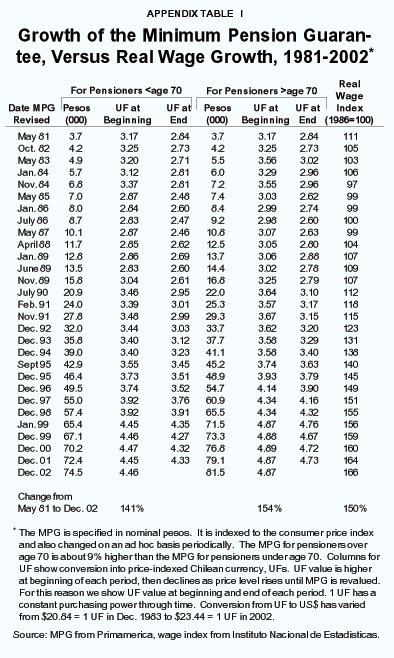
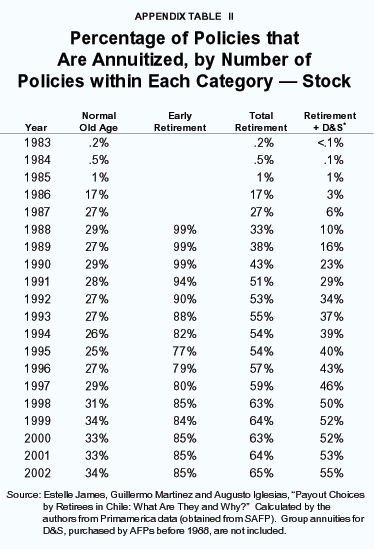
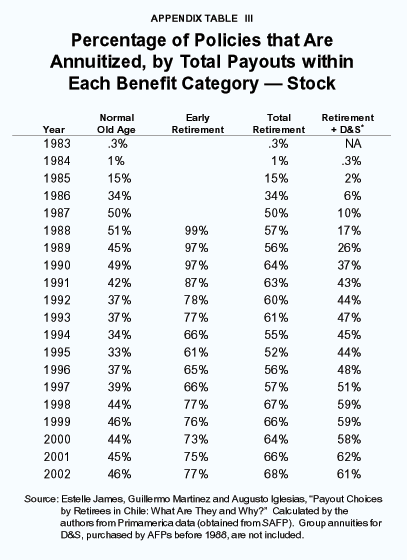
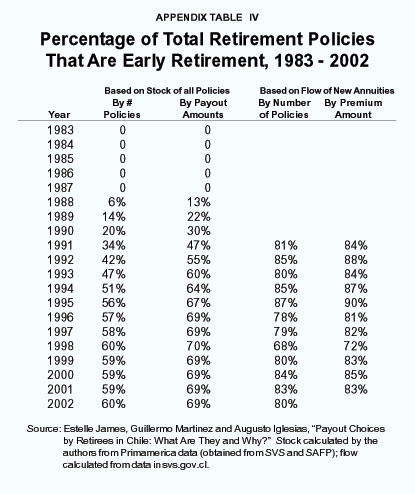
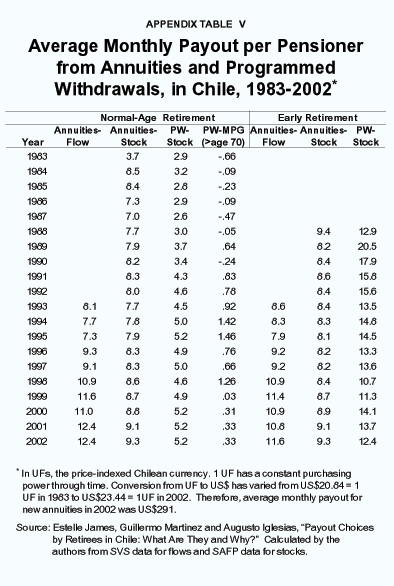
Estelle James, is principal author of Averting the Old Age Crisis: Policies to Protect the Old and Promote Growth (Washington, D.C.: World Bank and Oxford University Press, 1994) and is currently a consultant to the World Bank and other organizations. She was previously Lead Economist in the Research Department of the World Bank and Director of its Flagship Course on Social Security Reform. She also served as a member of the President's Commission to Strengthen Social Security in the United States.